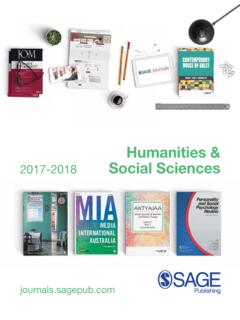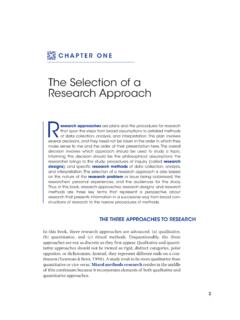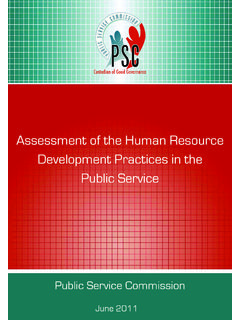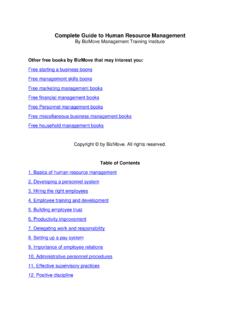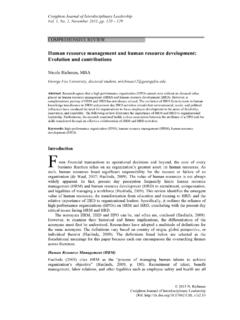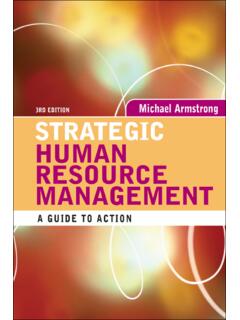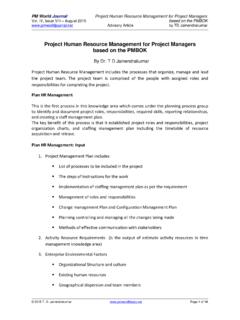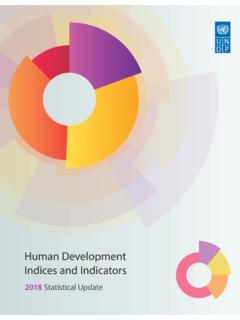Transcription of STRATEGIC HUMAN RESOURCE MANAGEMENT
1 STRATEGIC HUMAN 122-Jan-14 6:36:59 PMPA RT 1 THE ORGANIZATION, THE ORGANIZATIONAL CONTEXT AND 122-Jan-14 6:13:51 222-Jan-14 6:13:51 PM1AN INTRODUCTION TO THE ORGANIZATION, ITS ENVIRONMENT AND HUMAN RESOURCE MANAGEMENTGary Rees and Paul E. SmithChapter OverviewThe concept of an organization has changed remarkably over the last few decades, primarily as a result of changes to working practices, the advancement of technology and changing global practices and global economies. While an organization might be viewed as an entity, or a unit, it has by definition to interact with something else, be it customers, suppliers, shareholders, etc.
2 Organizational structures have moved away from traditional forms to encompass more virtual types and networked forms, often resulting in highly complex configurational designs. It is important to understand how the organization inter-acts with its environment and how the environment acts upon the organization. In addition to this is the need for organizations to sustain themselves in arguably an increasingly competitive environment. The continuing adoption of the Ulrich Business Partner model (see Chapter 4) by Western organizations impacts upon the way that the HUMAN RESOURCE function operates in both an inward- and outward-facing manner.
3 The drive for organiza-tions to act more strategically enhances the focus upon STRATEGIC HUMAN RESOURCE MANAGEMENT , which is the core emphasis of all the content presented in this Objectives xExplore the concept of an organization xExamine different organizational structures xExamine the role of HRM xExplore models of HRM xExamine the relationship between strategy, structure and culture xEvaluate how organizations interact within their environment xExplore the links between HR and 322-Jan-14 6:13:51 PMPART ONE4 CASE STUDY is currently responding to emergencies in 30 countries, from the conflict in Darfur, Sudan, to the humanitarian crisis caused by waterlogging in Bangladesh.
4 The demands of having to recruit people fast in a crisis situation and of sustaining long-term development work mean that HR is key to the success of Oxfam s programmes. Catherine Layton, the HR adviser in the employee relations team at Oxfam, explains how the charity manages its people around the is a highly devolved organization, with HR, financial MANAGEMENT and programme MANAGEMENT led by eight regional MANAGEMENT teams around the world, which span regions as large as South America or the Middle East, Eastern Europe and the Commonwealth of Independent States. Layton explains: There has been a deliberate strategy over the past five years to build up regional MANAGEMENT and have fewer people based in Oxford.
5 This means that when an emergency occurs in Haiti, for example, it would be the responsibility of the team in the Central America, Mexico and the Caribbean region to take the lead in organizing the lines for HR staff at Oxfam reflect the organization s devolved approach. Country-based HR staff report to HR managers in each region, who in turn are managed by their regional director, but also have a dotted reporting line to the organization s head of international HR. Regional HR practices and initiatives are sometimes not rubber-stamped by head office, but they are monitored and recorded.
6 The organization has an international people strategy to set principles for HR MANAGEMENT in every region; the process differs from Oxfam s HR strategy for other divisions, such as the trading or finance divisions in the means that while regions will follow Oxfam s international people strategy, pay and benefits framework and other HR procedures, they ultimately decide how to implement policies and pay their staff within regional budgets. Layton says:In Afghanistan, for example, pay has been agreed regionally, using local labour market infor-mation, and the reward team here in Oxford are notified of the salary scales.
7 If they wanted to increase salaries by x per cent in order for them to remain competitive in that country, they could contact our international reward person based here in Oxford for general, Layton says, this approach works well. If we find out that something has been agreed which goes against a policy, then that could be escalated to the HR director or reward manager, but that doesn t tend to be a major issue, she role of the country programme manager (CPM) the most senior MANAGEMENT post in each country where Oxfam operates is key to the charity s work. Layton notes that the make-up of the country manager workforce is closely studied and monitored by Oxfam, saying: If they are doing their job well it makes a massive difference to how our programmes work.
8 She estimates that just below half (48 per cent) of the country manager workforce is from Organization for Economic Cooperation and development countries with the remaining 52 per cent from developing CPMs may come from any country in the world, the organization endeavours to employ and develop local staff. We recruit locally where we can, Layton says, because immedi-ately that person can speak the language, can understand the culture and they may have useful 422-Jan-14 6:13:51 PMAN INTRODUCTION TO THE ORGANIZATION5connections in that country that s our preferred way of working.
9 For example, after the earth-quake in Pakistan in October 2005, the vast majority of the 500 staff recruited by Oxfam were Pakistani nationals, as is the CPM there. Some of these people were community workers, and we needed people from the community to do that work, she says. However, work permits can cause problems in recruiting outside staff, particularly for junior roles. For certain levels of job you won t be able to get a work permit so there s no point in recruiting someone outside the country, Layton some specialist roles, Layton acknowledges that there are countries where it is difficult to recruit people with certain skills.
10 So in a country which doesn t have a proper education infra-structure, it s harder to get a qualified accountant or a senior finance manager, for example, she says. However, Layton makes the distinction that the labour pool is from a global labour market rather than a Western one. There s international mobility but it s not all from Europe to Africa, she says. For example, we may have an Ethiopian working for us in Zimbabwe, or a Zimbabwean who works in South Africa. In addition to regional and country-based staff, a team of emergency staff coordinated from the Oxford headquarters, known as humanitarian support personnel (HSP), are ready to be sent anywhere in the world at a moment s notice.

